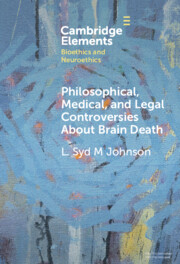Element contents
Philosophical, Medical, and Legal Controversies About Brain Death
Published online by Cambridge University Press: 22 February 2024
Summary
Keywords
- Type
- Element
- Information
- Online ISBN: 9781009323352Publisher: Cambridge University PressPrint publication: 21 March 2024
References
- 11
- Cited by

